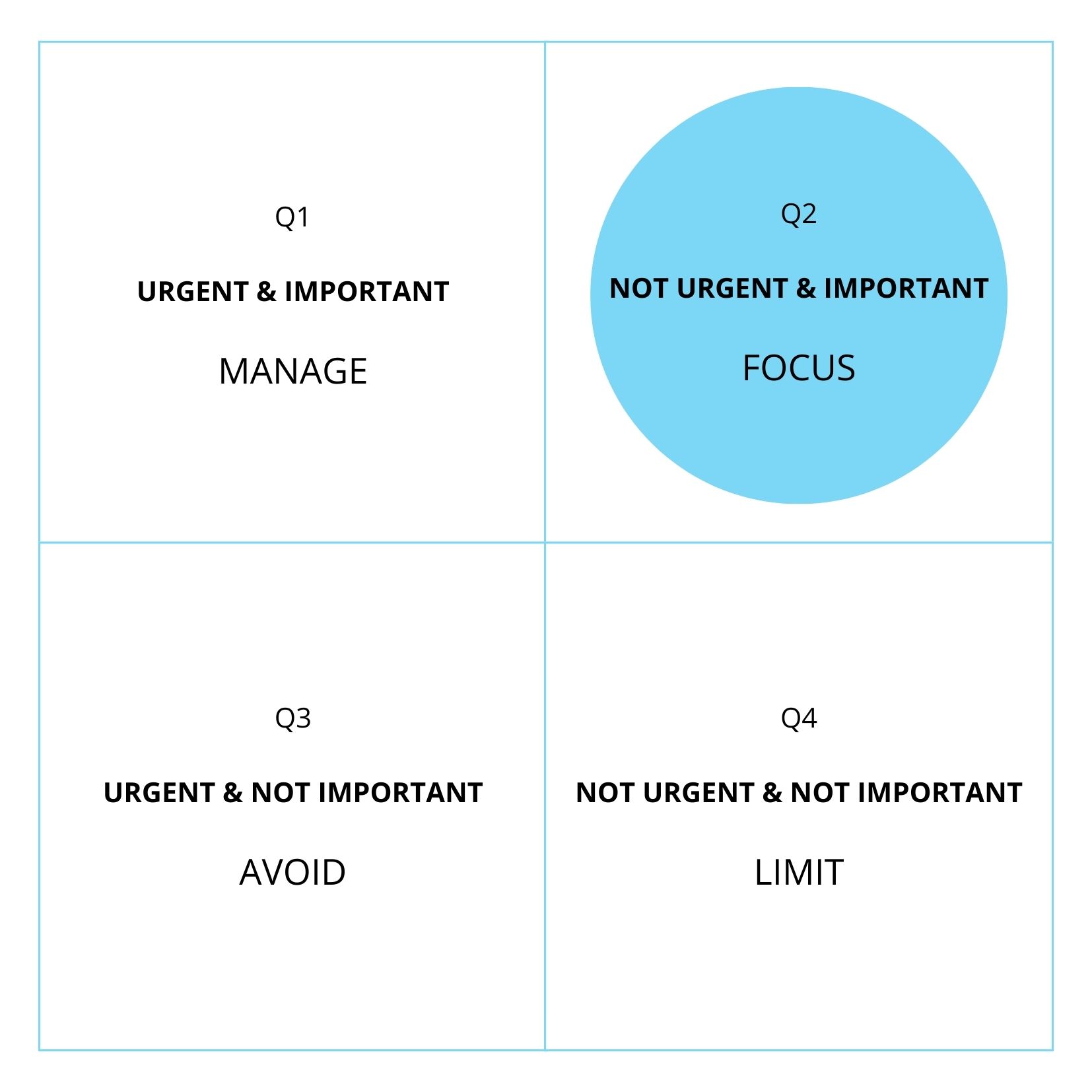Many primary English leads step into leadership with all the responsibility, but none of the support they deserve. Instead, they face full teaching loads, no leadership time and no TLR.
The ambition is there. But the capacity isn’t. What happens?
- Strategic work gets squeezed
- Monitoring and feedback feel rushed
- Leadership becomes reactive, not empowering
These leaders care deeply. They want to strengthen the curriculum and improve outcomes. But how do you lead strategically when time is so limited?
You can’t create time – but you can choose how to use it
When I was a subject lead, I made the mistake of trying to “find” time by working evenings and weekends. It wasn’t sustainable.
What I wish I’d known then: you can’t create more time, but you can decide where to put your energy. Stephen Covey’s Time Management Matrix is a great tool for that.

Covey’s Time Management Matrix: a quick explainer
- Q1: Urgent + important (Manage) – critical matters and stressors, such as crises, safeguarding, last-minute cover
- Q2: Not urgent + important (Focus) – strategic planning in direct relation to overall goals, such as curriculum thinking, team development, feedback
- Q3: Urgent + not important (Avoid) – distractions that appear urgent and important in the moment, such as admin requests, reactive emails, interruptions
- Q4: Not urgent + not important (Limit) – trivial tasks that cause the least amount of stress and are not directly related to goals
Most overwhelmed leaders spend their days firefighting in Q1 and Q3. But real impact happens in Q2. And here’s the good news: you don’t need big chunks of release time to work in Q2. Even ten minutes can move things forward.
Five ways to lead when time is tight
1) Use corridor coaching to build trust and culture
You don’t need a formal observation slot to offer feedback. A quick comment during a transition – for example, “I loved the way you modelled that sentence opener” – helps affirm good practice, reinforce intent and build trust.
These moments show your peers that leadership is relational, not just evaluative. Over time, this creates a culture where colleagues value your insights and are more open to change.
2) Link book looks to team dialogue
Don’t let book scrutiny become a standalone event that feels high-stakes or judgemental. Instead, bring books to a staff meeting and ask, “What do these show about how we’re teaching writing?”
This turns monitoring into development, builds a shared language of progression and reinforces the Writing Framework’s call for subject leaders to understand and support provision.
It also aligns curriculum intent with classroom practice – all without needing extra time.
3) Use team planning to co-construct success
When planning units together, focus on visible, assessable skills, for example, “use repetition to build urgency” or “control sentence length for effect.”
Co-constructing these goals sharpens everyone’s teaching and gives you a clearer lens when supporting or reviewing work. This is curriculum leadership in action: practical, not abstract.
4) Anchor conversations in outcomes, not activity
Instead of asking, “How did the lesson go?”, ask, “What did pupils learn about writing?” This subtle shift mirrors the Writing Framework’s focus on teaching as a process and encourages deeper reflection.
Used consistently, it raises the floor of professional dialogue across your team, especially in informal, unplanned chats that can otherwise drift.
5) Protect 30 minutes for strategic thinking
You might not get release time, but can you schedule 30 minutes every fortnight for Q2 work? Use it to reflect on patterns, revisit your subject vision, draft a short CPD input or plan a developmental check-in.
This time isn’t a luxury – it’s what enables everything else to make sense. Show that you use it well, and you’re more likely to be trusted with more.
What the Writing Framework expects
The Writing Framework lines up directly with Q2 leadership:
- Understand progression and pedagogy
- Monitor provision meaningfully
- Support teaching through modelling and CPD
- Contribute to curriculum clarity
- Use evidence to plan next steps
These are not “nice to haves”. They’re central to improving writing. They don’t need to be giant projects. They can begin with small, strategic habits. That’s Q2 leadership.
Influence first. Capacity later.
You don’t need a TLR to be a trusted, visible subject lead. But when you demonstrate strategic impact, you build your case for time and investment.
- Share outcomes from your Q2 work
- Use data or audits to highlight next steps
Align your asks with whole-school goals
That’s how leadership grows – from the inside out.
How we can help
At Leading English we help subject leads and SLTs make leadership real and sustainable – even when time is tight. We help you:
- Lead through influence, not just hours
- Align your work with frameworks and outcomes
- Build clarity, confidence and credibility





